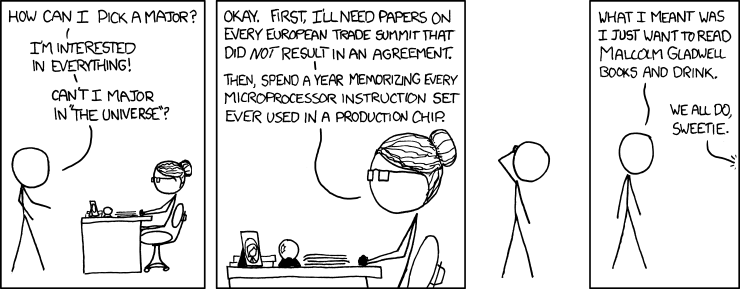-
Referring to IE6 as IE
Let’s face it: Internet Explorer 6 is the bane of everything cool about the web. It doesn’t support any of the awesome new technologies that have come out in HTML and CSS. But Internet Explorer has gone through three (almost 4) versions since IE6′s release in August 2001. Seriously. It’s absurd that we are still trash-talking Microsoft over a product that is more than a decade old. That’s like being up in arms over Windows ME (nobody liked it, but nobody criticizes today’s Microsoft over it).
In fact, if you go look at the browser usage statistics, you’ll see that out of all the versions of IE that show up in the data, IE6 is used the least. (IE7 comes next, then IE9, with IE8 topping everyone with a 25.9% market share). Both IE7 and IE9 have nearly twice the adoption rate of IE6. IE6 holds only 8% of IE users, and only 3.1% of the total market.

See the little tiny one, just behind Chrome 16? That’s IE6. See the big blue one at the top? That’s IE8.
Yet, despite the overwhelming data, I read over and over again that such and such a feature is not supported by IE, or that IE has such and such a bug. In the vast majority of cases, this is true only of IE6 (with the notable exception of the countless articles discussing IE’s support of CSS3 features, though most of them are supported in IE9, and half the time they are complaining about lack of support for proprietary –webkit-, –o-, or –moz– prefixed styles). While I don’t care if people designing with IE6 compatibility in mind (though I don’t and won’t unless a client insists on it), it’s really irritating when they blanket a decade of improvement under 2001 capabilities.
The Solution
Just look at the stats, and stop calling IE6 something it’s not. I know a lot of the articles are old, but very few of them predate IE7, and the ones that do should be updated or taken down.
-
Calling browser-specific tags "CSS3"
As A List Apart’s article Every Time You Call A Proprietary Feature CSS3 A Kitten Dies points out, styles prefixed by –webkit-, –moz, –o-, –ms-, or any other browser prefix are not standard and should not be called CSS because they’re not. While using these may not be entirely evil (though it leads to enormous, messy CSS files that quickly become dated and are difficult to maintain), calling them CSS is dishonest and misleading. When I was first learning CSS, I thought they were wonderful (mostly since I just used Chrome and the –webkit– prefixes are the most popular). This was mostly due to reading article after article talking about new "CSS3" tags that could be used to make everything shiny and happy.
The Solution
While I understand that your beautiful slideouts and fancy Web 2.0 animations are all pretty and beautiful, you should avoid using these as much as possible. They make for really, really cluttered CSS documents, are not future-proof, and are kinda evil. They kill kittens.
If you do insist on using them, don’t tell everybody else it’s "CSS3". In fact, tell no one you use them. Go cry in shame in a corner, and call yourself nasty names for criticizing IE for being "non-standards-compliant" while diligently puking out the glories of WebKit.
I’m just kidding. Seriously, don’t do that. People stare.
-
Blogging about technology by copying "About" pages
When looking up info on the WordPress.com Jetpack plugin for self-hosted WordPress sites, my Google results were bogged down by about 300 posts talking about the "new Jetpack plugin" that had copied (often word-for-word) the descriptions of the Jetpack features that you could find on the official Jetpack site as well as the info page you got once Jetpack was installed. My Jetpack search was simply the most recent example – I get similar results searching for info on Windows 8, iOS 5.1, or any other technology that had even a marginally public release. If you could just ignore them, it wouldn’t be as bad, but when they make up the first three pages of Google results, it’s a pain. It’s bad enough when someone copies another writer, it’s downright stupid when they copy the product’s own description.
-
Writing "Best of" posts by copying search results
Again, this one comes down to laziness. Over and over again, I see "best of" lists that are made up of the first few results found by searching on Google, WordPress.org, or some other basic site, followed by "descriptions" that are simply copied info pages (see point 3). These posts are completely useless, and bring absolutely nothing to the table. They are not ordered by merit, and almost never include any comments from experience. In addition, as with the above point, they hide actually useful articles under a giant pile of SEO-friendly spam.
-
Writing "visionary" posts with no technical backup

Every tech blogger seems like they need to make some grand statement about how the current tech world is wrong and why, usually providing their own general ideas for a solution. Unfortunately, these posts usually end, abruptly, at that point. Sure, all the browsers should follow and support the standardized tags and not add their own – but so what? Anybody can say that. What would be useful is explaining a future-proof system to get the features now. (My ideas center around using HTML classes and a simple jQuery-based extensible design language for client processing in JavaScript – but it’s not fully developed yet, so I’ll talk more when it is). Develop your idea, then present it – not the other way around.
So what else do tech bloggers do that needs to end? Tell me in the comments.
